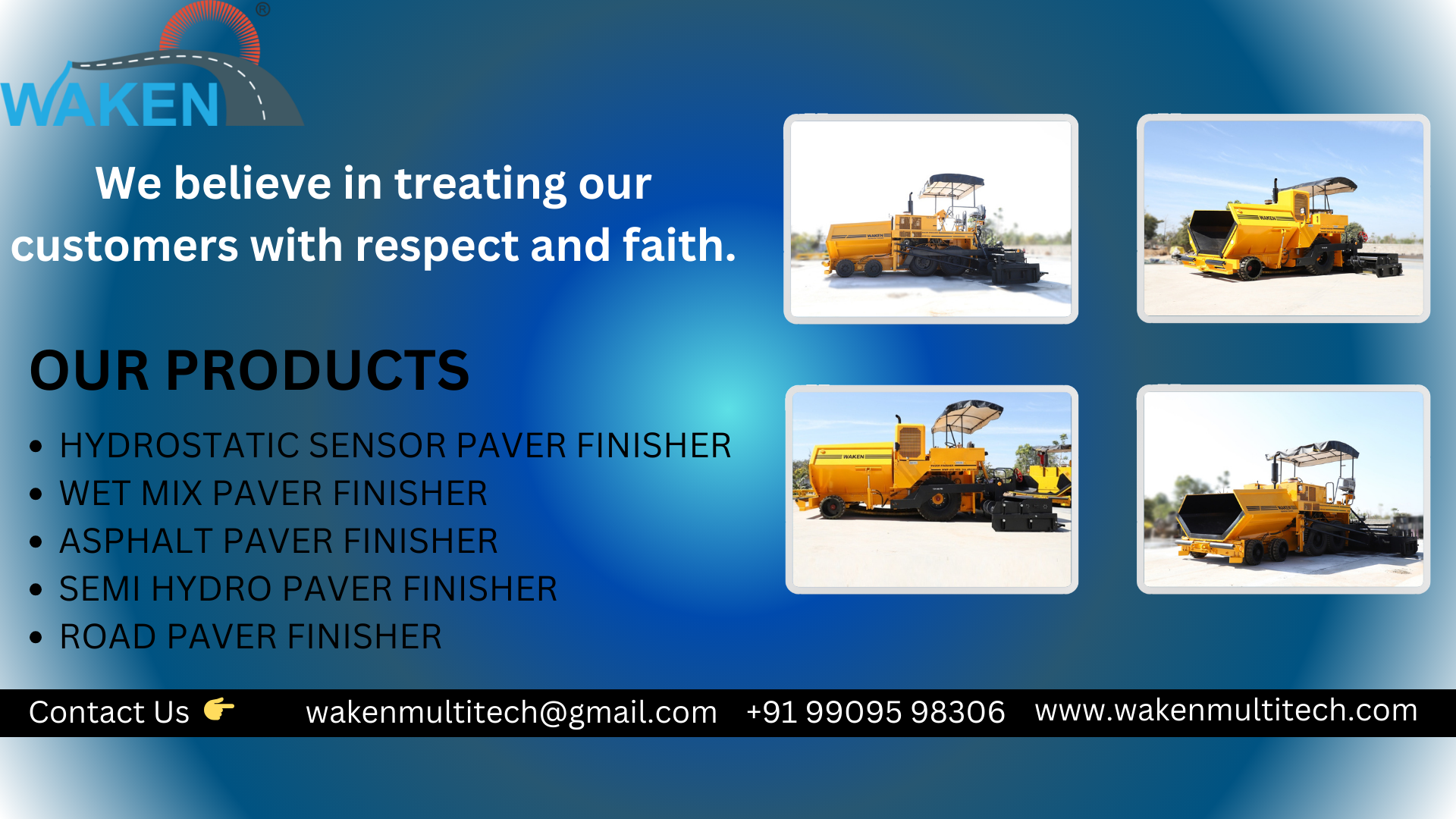Introduction to Unipave Sensor Paver
Unipave Sensor Paver machines are advanced asphalt paving finishers built for smooth, accurate road surfaces across India. With electronic grade and slope controls, they keep thickness uniform on highways, city overlays, and industrial corridors. Hydrostatic drives, robust augers, and heated vibratory screeds combine to deliver excellent mat texture and density, even during night shifts. Contractors value their productivity, consistent ride quality, and reduced rework on demanding schedules. For selection checklists, model comparisons, and deployment tips, visit our knowledge page before planning your next resurfacing package.
Working Principle and Process Flow of Unipave Sensor Paver
Hot mix asphalt is discharged into the paver’s hopper, then conveyors feed material to twin augers. Sonic sensors, slope controllers, and tow-point hydraulics continuously regulate the screed to maintain crown and thickness. The heated, vibratory screed spreads, levels, and pre-compacts, producing uniform texture across the width. Hydrostatic travel lets operators match truck delivery and roller timing to avoid thermal segregation and bumps across transitions. For setup steps, control calibration, and shift checklists, review our operations guide to align crew tasks before mobilization and handover.
Types of Unipave Sensor Paver
- Hydrostatic Unipave sensor paver for long highway stretches; consistent speed, precise grade control, and high productivity for EPC contractors.
- Wheeled Unipave sensor paver for urban corridors; quick relocation, tight turning, and minimal surface damage during night maintenance windows.
- Tracked Unipave sensor paver for industrial parks and airports; superior traction, stability, and gradeability on weaker subbases and gradients.
- Compact-width Unipave sensor paver for city overlays; narrow screeds, rapid setup, and safe operation alongside live traffic and utilities.
- High-compaction screed Unipave sensor paver; enhanced heating, vibration, and density for premium surfaces carrying heavy mixed traffic loads.
Key Features and Specifications of Unipave Sensor Paver
- Hydraulically extendable screed from 2.5–9.0 metres with bolt-on extensions for specialized widths and shoulders.
- Automatic grade and slope control accuracy within ±1.5 mm delivers smoother ride quality and consistent layer thickness.
- BS Stage IV compliant diesel engine with heavy-duty cooling package optimized for Indian ambient heat and dust.
- Proportional conveyor and auger drives with independent controls ensure uniform material flow and minimal segregation.
- Centralized lubrication points, onboard diagnostics, and nationwide spares support reduce downtime and lifecycle maintenance costs.
Applications of Unipave Sensor Paver
- National highway mainline paving where uniform thickness, tight joints, and superior ride indices are mandated; Unipave sensor guidance and hydrostatic travel stabilize speed, reducing stops, overuse of mix, and rework under aggressive NHAI scheduling.
- Urban arterial overlays executed during restricted night windows; compact configurations maneuver around medians and utilities, delivering smooth transitions at intersections, bus bays, and approaches with minimal disruption to traffic, businesses, and residents across dense corridors.
- Airport taxiways, service roads, and aprons demanding tight tolerances; automated grade, slope, and thermal management help achieve density, minimize segregation risk, and maintain surface smoothness to reduce foreign object damage concerns for ground operations.
- Industrial park roads and heavy-duty pavements supporting forklifts, dumpers, and articulated trucks; tracked traction and high-compaction screeds produce durable mats that resist rutting, deformation, and premature cracking on varied subgrade strengths and climatic conditions.
Benefits of Using Unipave Sensor Paver
- Higher ROI through faster cycle times, fewer corrective passes, and extended pavement life; sensor controls cut material waste, while uniform compaction and texture reduce future maintenance interventions across diverse Indian climates and traffic categories.
- Improved quality consistency with precise electronic leveling; standardized screed heating and vibration minimize segregation and shoving, delivering ride comfort, safety, and durability that lower warranty claims and enhance public satisfaction on completed corridors.
- Shorter project durations by synchronizing paver speed with trucks and rollers; hydrostatic drives, preset controls, and optimized logistics reduce idling, cold joints, and thermal differentials during constrained work windows and demanding urban environments.
- Operational scalability from narrow city lanes to wide highway sections; modular screed extensions, robust diagnostics, and safety interlocks help teams maintain compliance, visibility, and repeatability under rigorous site audits and contractor EHS frameworks.
Top Manufacturers and Suppliers in India
India’s market for sensor pavers features a mix of established domestic manufacturers and international brands supplying wheeled and tracked variants. Typical offerings include hydrostatic drives, electronic grade and slope controls, heated vibratory screeds, and hydraulically extendable widths suited to highways, airports, and municipal overlays. Vendors commonly provide commissioning support, operator training, and regional service centers with stocked consumables such as screed plates, auger flights, sensors, and hoses. Procurement teams usually compare accuracy specifications, fuel efficiency, electronics reliability, parts availability, and warranty terms alongside delivered productivity. Rental fleets and EPC contractors often maintain multi-brand inventories, so transport width, setup speed, and control familiarity influence selection. Lead times can fluctuate with seasonality; early planning and pre-dispatch inspections help ensure uptime during critical paving windows.
Maintenance and Safety Tips
- Check sensor brackets, tow arms, and screed fasteners daily for looseness, wear, and alignment.
- Clean conveyors, augers, and heating zones after shifts; lubricate points according to OEM schedules.
- Calibrate grade and slope controls against references before each shift and after transportation.
- Train crews on emergency stops, reversing alarms, hot surfaces, guarding, and lockout procedures.
- Store critical spares and cover equipment; protect connectors from moisture, dust, and accidental damage.
FAQs – Unipave Sensor Paver
Contact Details
Talk to our specialists today for tailored solutions and fast assistance.
